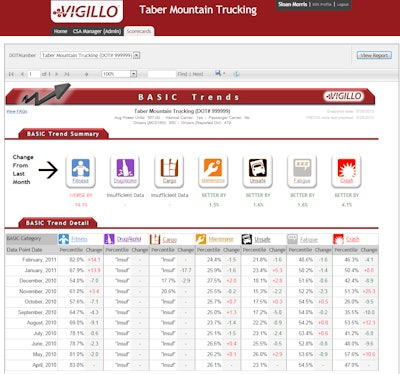 Vigillo has been providing CSA scorecards and data mining products in the transportation industry for more than nine years.
Vigillo has been providing CSA scorecards and data mining products in the transportation industry for more than nine years.Managing driver safety and compliance can be a high-risk, time consuming process.
Staying on top of the data stream can be difficult with onboard computers and telematics systems pushing email alerts for every critical safety event – speeding, harsh braking, hours-of-service violations, and more.
A growing number of fleets also use video event recorders to capture additional data and risk observations.
Consumed by data, managers may not have enough time to remediate the risk that surfaces in their data by holding coaching and training sessions with drivers.
In the aftermath of an accident, plaintiff attorneys will likely seek punitive damages by proving that management knew — or should have known — of risks but failed to act in a timely manner.
For these reasons and others, technology providers see a demand for automated risk management systems.
Automated response
Recently, Vigillo and J.J. Keller & Associates joined forces to create an automated system to analyze and remediate risk.
Vigillo’s big data analytical platform, called Athena, captures fleet CSA violations from roadside inspections as well as real-time critical event and hours-of-service data from telematics systems. Fleets use the platform to identify areas of risk and deficiencies.
J.J. Keller has a library of online driver training courses. The companies have been working to map J.J. Keller’s training courses, by topic, to the specific areas of deficiency that Vigillo identifies for its fleet customers based on their CSA and telematics data, among other data sources.
If a driver has a speeding event, for instance, Vigillo automatically assigns the driver an online training course from J.J. Keller on speeding. Similarly, a driver with an hours-of-service violation, a bad pre-trip inspection, or other risky or non-compliant behavior would be assigned the appropriate training modules.
 Vigillo will send drivers online training assignments from J.J. Keller when its analysis of fleet CSA and telematics data indicates an area of risk.
Vigillo will send drivers online training assignments from J.J. Keller when its analysis of fleet CSA and telematics data indicates an area of risk.When the training is assigned to a driver, the driver automatically receives an e-mail with a link to take the online module. J.J. Keller updates Vigillo’s database with the status of the training and the results.
Steve Bryan, chief executive of Vigillo, says the system is designed to not overwhelm drivers with training videos. Training assignments could be prioritized based on a hierarchy of risk factors, for example.
Overall, the system will work like a “doctor-patient relationship,” he explains. Vigillo will diagnose the problem and assign the appropriate J.J. Keller training module for the prescription.
The doctor-patient relationship doesn’t end with a training prescription. Vigillo will continue to monitor the fleet’s CSA and telematics data and schedule check-up visits, so to speak, to determine if the prescription is working, he says.
Assuming the prescription works, a fleet should see a steady decrease in violations and crash risk.
Likewise, J.J. Keller will use the ongoing analysis to find areas where new and more customized training courses can address risk factors, says Brian Kubiak, director of marketing for J.J. Keller training.
 The Telogis Coach app is an automated tool for driver performance reporting.
The Telogis Coach app is an automated tool for driver performance reporting.Vigillo will begin pilot testing the new system next month, Bryan says, and will offer it to fleet customers for a flat fee, per driver, and require an annual contractual agreement.
Directed training
Instructional Technologies, Inc. (ITI), developer of Pro-Tread online driver training courses, has been working with telematics providers and its fleet customers to automatically assign Pro-Tread training courses based on critical safety events.
As an example, Dr. Jim Voorhees, chief executive of ITI, mentioned the possibility of automatically assigning training to events captured by Telogis Coach, an optional app for the Telogis cloud-based fleet management platform.
Fleets use Telogis Coach to give drivers real-time feedback and alerts for safety and performance. Once Telogis Coach catches an exception, like a driver speeding or hard braking, a Pro-Tread training module could automatically be assigned to the driver to complete, he says.
Gorilla Safety offers a mobile fleet management system that comes complete with electronic logs, driver vehicle inspection reports (DVIRs), document management, accident reporting and more features.
The company says the system will include a scorecard feature for drivers and managers by the end of this year. The scorecard will give drivers instant alerts and a summary view of their safety and compliance performance. This in-cab mobile app will help fleets fix problems in real time rather than waiting for a reactive response from management, says Tommy Johnson, co-founder of Gorilla Safety.
 Gorilla Safety’s fleet management system is available for iOS and Android devices
Gorilla Safety’s fleet management system is available for iOS and Android devices“If you give some type of alert or notification in the cab that changes behavior,” he says. “That is the way we are all wired. It is aggravating to hear a beep, and you will be conscious of that.”
Gorilla Safety is developing an automated write up process for when drivers operate outside safety and compliance parameters. An instant notification would be sent to the fleet manager, who then would choose one of three possible responses to streamline the process.
The manager could press option #1 to write up the driver, option #2 to ignore it and type in notes to explain why, and option #3 to train the driver. Currently, the training would be a text or Word document explaining the company policy to the driver, says Mark Walton, co-founder of Gorilla Safety.
“We want to make a manger’s life as easy as possible,” he says.






![Platinum-80inSleeper(RGB-300dpi)[1]](https://img.ccjdigital.com/files/base/randallreilly/all/image/2015/12/ccj.Platinum-80inSleeperRGB-300dpi1.png?auto=format%2Ccompress&fit=crop&h=167&q=70&w=250)






